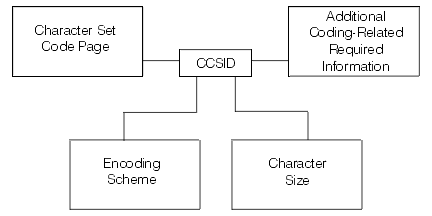Support for the national language of any country requires the proper handling of a minimum set of characters.
A cross-system support for the management of character information is provided with the IBM® Character Data Representation Architecture (CDRA). CDRA defines the coded character set identifier (CCSID) values to identify the code points used to represent characters, and to convert these codes (character data), as needed to preserve their meanings.
- More than one national language version is installed on the iSeries™ server.
- Multiple iSeries servers are sharing data between systems in different countries with different primary national language versions.
- iSeries servers and non-iSeries servers are sharing data between systems in different countries with different primary national language versions.
Tagging is the primary means to assign meaning to coded graphic characters. The tag might be in a data structure that is associated with the data object (explicit tagging), or it might be inherited from objects such as the job or the system itself (implicit tagging).
DB2 Universal Database™ for iSeries tags character columns with CCSIDs. A CCSID is a 16-bit number identifying a specific set of encoding scheme identifiers, character set identifiers, code page identifiers, and additional coding-related information that uniquely identifies the coded graphic character representation used. When running applications, data is not converted when it is sent to another system; it is sent as tagged along with its CCSID. The receiving job automatically converts the data to its own CCSID if it is different from the way the data is tagged.
The CDRA has defined the following range of values for CCSIDs.
- 00000
- Use next hierarchical CCSID
- 00001 through 28671
- IBM-registered CCSIDs
- 28672 through 65533
- Reserved
- 65534
- Refer to lower hierarchical CCSID
- 65535
- No conversion done
See Character Data Representation Architecture - Level 1, Registry for a complete list of the CDRA CCSIDs.
The following illustration shows the parts of a CCSID.
